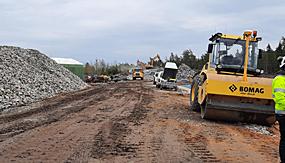
Civil engineering in the Kulloo area in Porvoo, Finland. © Enni Flykt
A circular economy business park is being built in the Kulloo area in Porvoo, Finland with civil engineering that utilises circular economy to a significant degree. Kulloo will be built as part of Kilpilahti, the largest oil refining and petrochemical cluster in the Nordic countries. There are more than 40 companies operating in the area.
Circular economy principles were part of the quality criteria in the tendering procedure of the civil engineering for the Kulloo business area. The winning bid totalled approximately EUR 5.7 million, which is only approximately half of the estimated value of the procurement without circular economy solutions.
”Before this, no competitive procurement procedure in Finland has been linked to circular economy or related criteria. Our project demonstrates that there is a lot of potential in the circular economy of soil,” says Enni Flykt, Community Planner for the City of Porvoo.
The civil engineering in the area aims to achieve mass balance in accordance with the principles of the circular economy. This means that soil and rock material extracted and mined for construction purposes are processed and utilised within the area, thereby saving valuable natural resources. Reducing the amount of material transported to and from the area also reduces heavy traffic to the area. There will be an overall reduction in the emissions and costs of construction.
Soils circulate
The Kulloo area is well suited as a pilot site, as there is already an existing industrial area with road networks. The project made use of a wide range of land types that were available on the site.
The structural layers of the old road network are used for the construction of the new network. Rock crush extracted from new plots is used to supplement the crushed rock from the demolition. ”Together, these will ensure that there is no need to import any virgin rock material from outside, according to what we know now. This will also speed up the project's schedule, and enable companies to build more quickly on the sites,” says Flykt.
There is also soil rich in humus in the area, which is used for landscaping of the protective green areas and road ramps. ”Clay soil can also be partly used in terrain structures and noise barriers in the protective green area,” says Flykt. Some of the clay contains sulphur. It and any soil found at the site that is contaminated over the threshold value will be utilised with an environmental permit within the site. Soils that are more heavily contaminated will be removed from the site.
The contractor has also identified a nearby construction site to utilise clean land extracted from fields.

Excavation work in the Kulloo area in Porvoo, Finland. © Enni Flykt
Managing stormwaters
Sustainable management of stormwaters is one of the main objectives of the area's zoning plan, in addition to the utilisation of land masses. The aim is to properly manage also stormwater from existing industries in the area.
Each company in the area has had its own stormwater storage and management solutions, such as ditches. Two retention basins, one sedimentation basin and a limestone dam were built for the management of stormwater in the old industrial area and the newly built area.
”The stormwater structures are used to smooth the flow of rainwater in the area and improve the quality of water before it is discharged into nearby fields. The limestone dam adjusts the pH of the water to nearly match natural water,” says Flykt. “The quality of stormwater is monitored constantly.”
Education, software and legislation must be developed
The project included creating new practices, but also faced challenges. ”Compliance with the circular economy raised a lot of questions in relation to practical work. For example, the contractor did not understand at the beginning why road debris could not be taken outside the area and that soil rich in sulphur had to remain in the construction area,” Flykt says.
“That is why contractors should be offered further training in order to enable them to plan their work already at the tendering phase to ensure there are no misunderstandings and to promote circular economy of civil engineering becoming mainstream in Finland.”
In addition, the local licensing authority split the permits into several parts, meaning the permit did not abide by the one-stop-shop principle. ”Regulation on the recovery of soil waste in construction would indeed be needed, for example to clarify the definitions of waste,” Flykt recalls.
The project also revealed that good quantity surveying software that supports a circular economy approach is needed for calculating tenders. The software could take into account different soil varieties from a recycling perspective. ”The civil engineering side should be involved in updating the building codes and software. The better each sector understands the needs of others, the better the plans can be made to fit the circular economy,” explains Flykt.
Kulloo business area is a pioneer in circular economy
The Kulloo area is of interest to new companies -– there are already a lot of potential plot buyers at the construction stage. The area has a lot of potential in terms of sustainability.
”The overarching idea of the circular economy park is to increase the number companies that utilise Kilpilahti's side streams. For example, we have identified waste heat and other side streams that are not yet utilised at all. In the future, we will also develop a special circular economy area in Porvoo that would also serve residential construction.”
Learn more
Further information
- Enni Flykt, Community Planner, City of Porvoo, enni.flykt@porvoo.fi